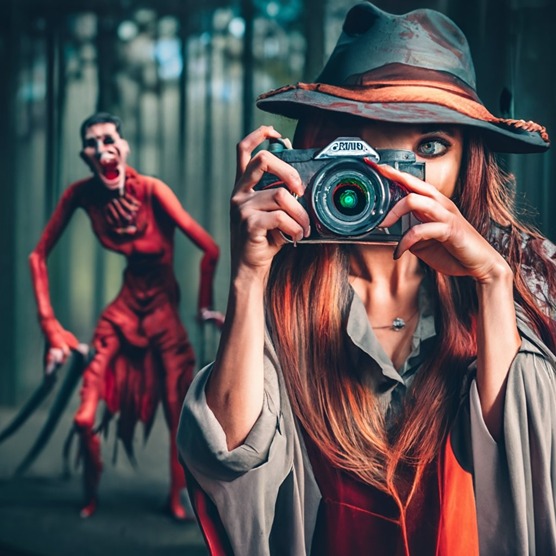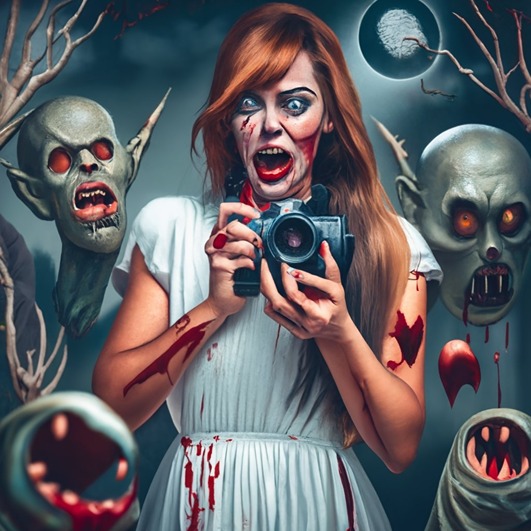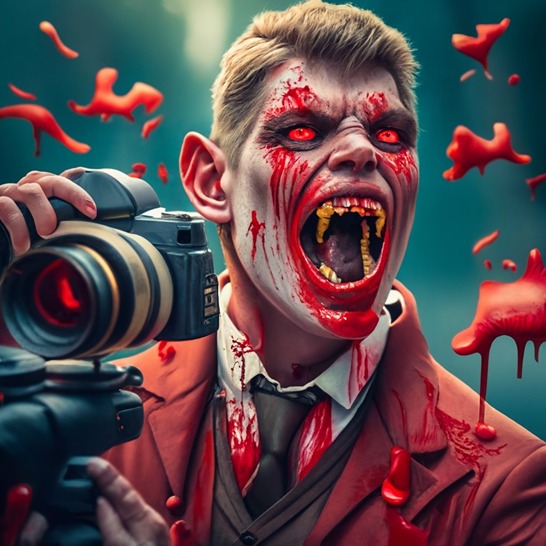Say Cheese And Die With Horror Photography
I have always loved taking pictures. At a certain point in my life, when I was involved in photography and video editing, I even thought of making a profession out of it. Eventually, the stars directed me elsewhere, but photography remained a hobby. At every opportunity, I take my smartphone – as befits the 21st century, the camera is hidden in the closet for too long as storage – and try to take a picture of landscapes, people, and objects that seem scary to me. The number of my worthy works in this field is minimal because real horror pictures require investment, thought, creative sense, and, often, additions in the form of makeup, lighting, scary props, etc. Fortunately, there are enough photographers to admire their terrifying creations.
One of the subgenres of horror art is horror photography, which we will deal with in the following article. The fact that horror photography exists within our playing field should not surprise you. Horror, after all, is a genre that has fascinated and frightened people for thousands of years, from ancient myths and legends to modern films and literature. Expressing horror through different visual media, such as painting, sculpture, digital art, and photography, is possible. One can take horror photographs using digital, smartphone, or web cameras and edit the photos using different software and apps. Horror photography can also be combined with other elements, such as costumes, makeup, props, lighting, or special effects, to create more realistic or dramatic images. In short, the sky is the limit, and the catalog of horror films only increases yearly.

What Is Horror Photography?
The answer may be in the body of the question. Horror is one of the few genres in cinema whose name indicates its primary purpose: to evoke an emotion (of fear and terror, of course). Horror photography works on roughly the same principle. It is a type of digital art that uses photography as the primary medium to create scary, disturbing, or creepy images.
We can make scary photography in different ways, for example:
- Photos of real or staged scenes that include horror elements, such as haunted places, scary dolls, injured people, or scary masks.
- Pictures of yourself or others in horror costumes, makeup or poses, such as zombies, vampires, clowns or witches.
- Pictures of ordinary objects or situations and adding horror effects, such as filters, colors, textures, or distortions, to make them look sinister, grotesque, or surreal.
- Photos of abstract or random shapes and patterns, which the viewer may interpret as horror images, such as faces, eyes, or creatures.
- Pictures of existing horror pictures and modifying them, for example, cropping, collaging, or merging, to create new or different horror pictures.

💀 Killer Deals & Scary Recommendations 💀
🎭 Costumes & Accessories
HalloweenCostumes Fun Costumes Entertainment Earth
🛒 Online Shopping
AliExpress Amazon Walmart Etsy
🧛 Collectibles & Horror Brands
Funko Hot Topic Lego Spirit Halloween
🎢 Attractions & Tours
GetYourGuide Tiqets Viator Klook
📖 Blogs & Horror Sites
Bloody Disgusting iHorror Fangoria
🩸 Disclaimer: Some links are affiliate links. The price stays the same – it just helps keep the site alive 👻
The Scary Sides Of Images
The world of horror photography is broad by any measure, as no unequivocal definition of photography meets this definition. Some digital horror artists use realistic and detailed techniques to create images that look like photographs. In contrast, others use stylized and abstract methods to create images reminiscent of paintings or scenes from horror movies. Along with the still images, which can be edited and graphically processed in many ways, some horror artists also use animation, sound, or interactive elements to enhance the fear levels of their images.
Horror photography can use different techniques to create compelling, original, or artistic scary images. Some of the standard techniques used in scary photography are:
Shadows
Shadows can create a sense of mystery, suspense, or danger. The main purpose here is to hide or reveal parts of the image. They can also create shapes or forms that suggest horror elements, such as figures, claws, or teeth.
Lighting
Lighting can create mood, atmosphere, or contrast using different colors, intensities, and directions. Another option is to make other effects, such as glows or flashes. Lighting can also highlight or emphasize certain features or details of the image, such as eyes, blood, or wounds, to make them scary.
Makeup
Makeup may change the photography subjects’ appearance using different colors, textures, or materials. Creative makeup artists can create real effects, such as scars or wounds, and even create characters out of nothing. Makeup can also enhance or exaggerate certain features or expressions of the face or body.
Accessories
Using objects associated with horror themes, such as knives, chains, skulls, or candles, can turn standard images into terrifying ones. Props can also create context for an image or even the plot of a story by using objects related to the image’s location, time, or genre.
Special Effects
Special effects can create illusions, surprises, or shocks using techniques that are not possible or realistic in real life, like smoke, fire, or blood. The effects are created during the shooting or editing and graphic processing stages.

Tips For Horror Photography
Horror photography can be seen as a way to express one’s imagination, creativity, or emotions. Sometimes, a person uses horror photography ideas it to explore his fears, anxieties, and fantasies.
The first step to creating scary images is knowing your audience. Before making horror pictures, consider who you are making them for and what you want to achieve with them. Do you want to scare, entertain, or impress with the pictures? Is your goal to express yourself or tell a story? Do you want to follow an existing trend or try to create a new one? The answers to these questions can help you choose suitable horror themes, elements, or techniques for your photos.
Think in advance about what your genre is! Horror is a broad and diverse genre with many sub-genres, such as supernatural, psychological, slasher, or zombie. Each subgenre has conventions, clichés, and elements that heighten the fear. These can be used as inspiration or even as a parody of your photos. Knowing the genre you’re working in can help you choose the right horror style, aesthetic, or quality for the images. The same goes for the target audience: it is clear that those who want to produce scary images for children need to make them a little more subtle compared to the pictures intended for adults.
It is essential to know what our limits are, both on a technical level (because only some are as talented as top horror photographers in the world) and when it comes to how the image is created. Shooting horror can be fun but also dangerous, especially if it involves actual or staged scenes that include horror elements, such as blood, fire, or weapons. Before creating scary images, think about the safety, legality, and ethics of your actions. Yes, because sometimes people try to imitate pictures they see online.

Where Can You Get Horror Photography Ideas? Everywhere!
Horror photographers can get inspiration from different sources. It is important to emphasize that, in many cases, the key to success is practice. Shooting horror can be challenging, but it can also be rewarding. In other words, you can always experiment and have fun creating pictures because your results should improve as you try and practice. You can see this, for example, in the horror drawings, including in the guides we made for you on the correct way to draw the great icons of the horror world. Like everything else in life, right?
You can find the inspiration for those terrifying images (sometimes literally) in the texts surrounding us, especially horror movies, TV series, books, video games, etc. You can play on those fears or even use horror objects or characters as part of the shots. If you go through many of the horror images available on the web, you will see that many of them have the presence of a famous horror villain, such as Freddy Krueger, Pennywise, or Michael Myers. You will likely find that the location chosen for the shoot is a place that is considered scary, such as a forest, a basement, or a cemetery (whether a real place or one created with the help of set design or graphics).
Some people create scary pictures from their personal experiences, especially their fears, nightmares, or fantasies. We have heard quite a bit about first-class photographers who tried to recreate a nightmare they had during one of the nights or to give form to the fear that had accompanied them for years. To know what to create, you have to think about what scares you, so the creator can certainly explore his subconscious and use that as a basis for your images. For example, people who are afraid of clowns or dogs can make them their photography subjects.
The truth is that horror surrounds everyone; you don’t need to turn on the news to know that. The environment or the objects surrounding us can be a source of horror images, usually with a bit of imagination or thinking outside the box. You can observe your surroundings and find “normal” objects to turn into horror images through technical decisions or the possibility of creating natural horror scenes here. Of course, many scary pictures include things like knives, masks, or dolls because that’s what we’re used to, and that’s scary visually.

What Type Of People Are Into Horror Photography?
There is no absolute answer to the question of what type of people are into horror photography, as different people have different reasons, tastes, or preferences for this genre. However, the desire to create or see such images often depends on one’s personality. Without trying to make too complex a psychological analysis, there is no doubt that some people have a personality trait that makes them more attracted to horror photography, such as a desire to experience thrills from the safe place behind the camera or even in examining the final results of scary images that others have created.
As we mentioned before, horror is based on emotion – and this explains a lot of the attraction of a large part of us to images that are considered scary. Some people may use scary photography to deal with emotions like fear, anger, or sadness. These people may find the horror film a form of catharsis or even a therapeutic act, as it may help them confront, release, and overcome their negative emotions. Horror photography may also provide a safe and controlled way to experience fear without danger or harm.

Culture plays a role here. Some people may be influenced by their cultural background, values, or beliefs to appreciate horror photography and create scary images. Horror photography may also provide a way to express or communicate one’s cultural identity, values, or beliefs. Scary pictures can be self-expression, whether you create or look at them. People hang scary pictures on their walls to express their cultural preferences.
The last aspect is the craftsmanship. Some women may be interested in horror photography as an art form and may appreciate its aesthetic, technical, or creative aspects. These people may find a horror photograph beautiful, impressive, or inspiring because it may demonstrate the horror photographer’s skill, talent, or vision. Horror photography may also provide a way to explore or experiment with different artistic styles, techniques, or themes to create original and innovative horror images. People can sell their horror photos, and make it even their main job.
Famous Horror Photographers
Horror photography is a relatively new and evolving form of digital horror art. Still, it has already produced some notable and influential horror photographers who have created scary, disturbing, or unsettling images.
Some of the familiar horror photographers are:
Joshua Hoffine
Joshua Hoffine is an American horror photographer known for his images that explore the nature of childhood fears, such as monsters, ghosts, or darkness. He stages his photoshoots like small movies, with sets, costumes, props, and special effects, and often uses his children as models. His photos have been featured in numerous publications and exhibitions worldwide.
Miss Lakune
Miss Lakune is a French horror photographer known for her images depicting horror themes, such as death, madness, or torture. She uses herself as the primary model and applies makeup, costumes, and props to transform her appearance. She also uses editing software to create effects like blood, fire, or distortion. Here is her Instagram account for some inspiration.
Christopher McKenney
Christopher McKenney is an American horror photographer known for his images that combine horror and surrealism, such as faces, bodies, or objects that are distorted, mutilated, or missing. He uses digital manipulation to create his images and often uses himself or his friends as models. His horror photos have been shared and praised by many celebrities and artists.



